Abstract
A prospective, randomized, double-blind trial of the nutritional effects of branched chain modified amino acid solutions was undertaken in 23 surgical patients within 24 hours of the onset of major general surgery, polytrauma, or sepsis. The effects were evaluated in the absence of abnormalities of oxygen transport and perfusion in an isocaloric/isonitrogenous setting where the major difference between the groups was the amount of branched chain amino acids received. Both groups received balanced parenteral nutrition with 1.5 gm/kg/day of amino acids, 30 calories/kg/day of glucose, and 7 calories/kg/day of fat. At the end of the 7-day study interval, the group receiving the branched chain enriched therapy at 0.7 gm/kg/day of branched chain amino acids had improved nitrogen retention; an elevation of their absolute lymphocyte count from 800 to 1800/mm3, a reversal of anergy to recall skin test antigens in 60% of the patients, and improved plasma transferrin levels (p less than 0.03). Nutritional support using the modified amino acid metabolic support solutions has beneficial effects during the stress interval that do not seem as achievable with current commercially available nutritional support regimens.
Full text
PDF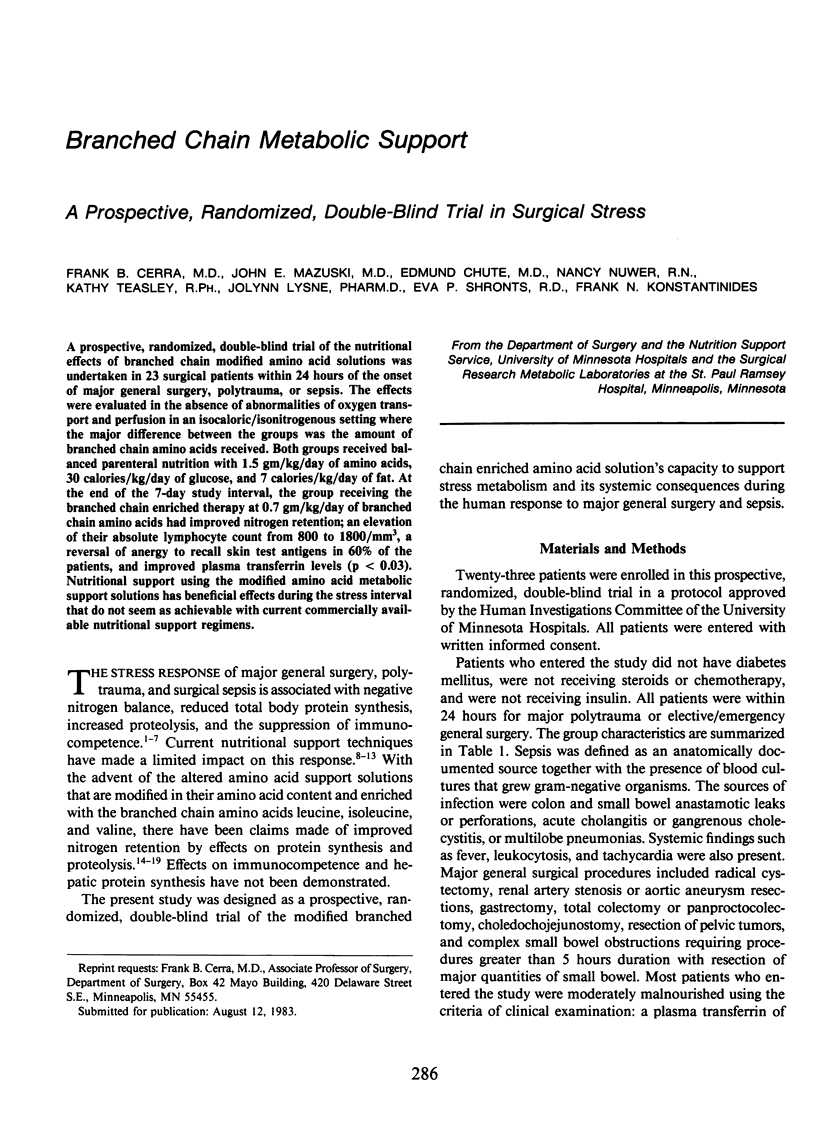
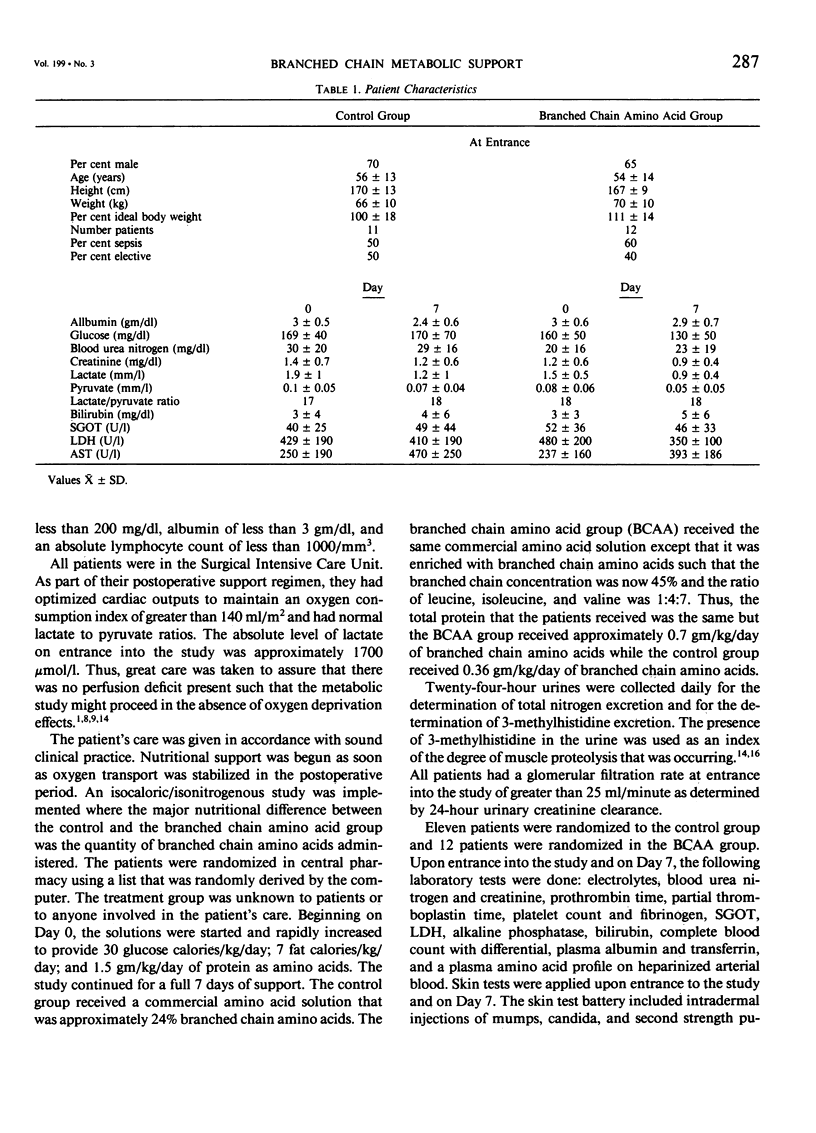

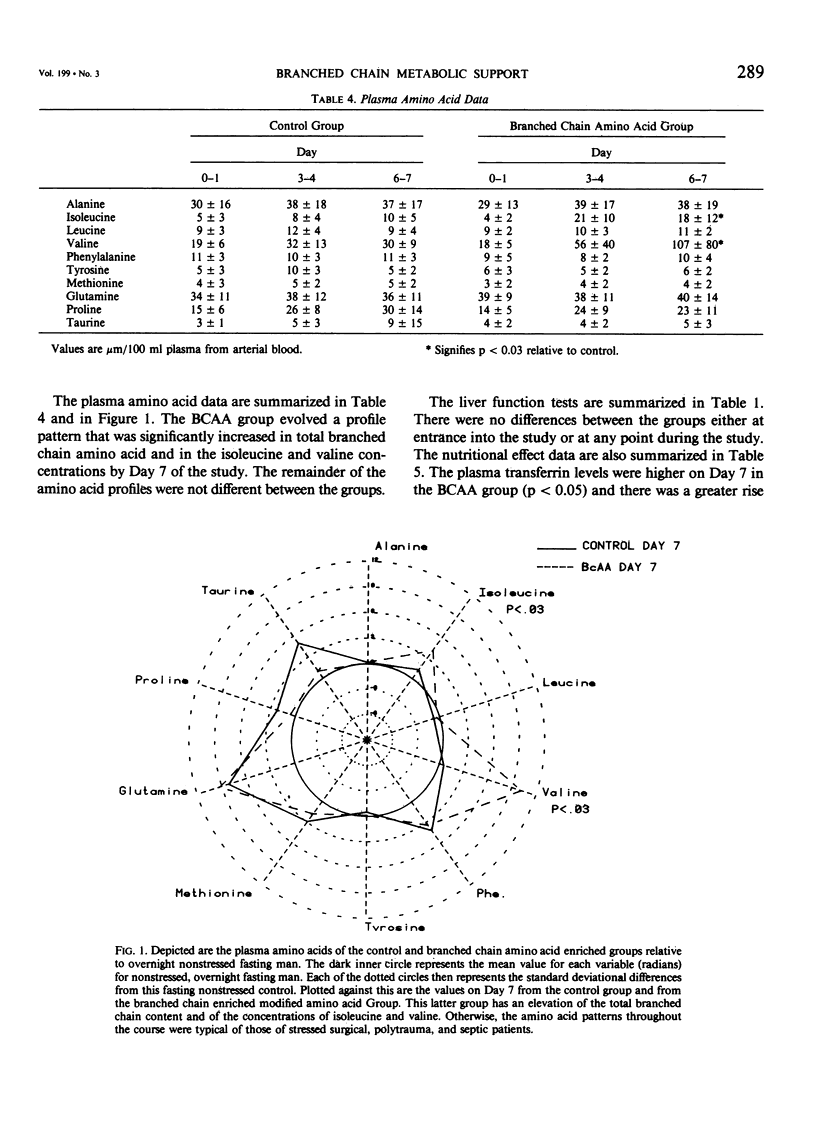
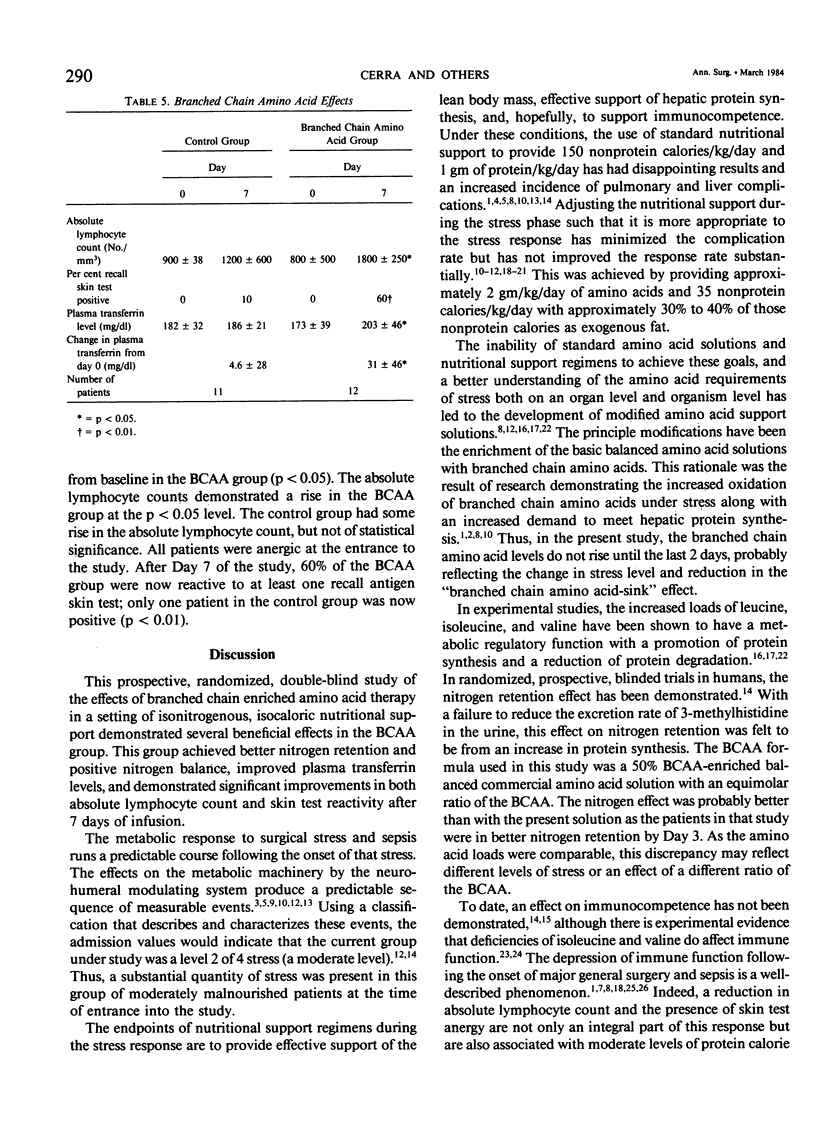
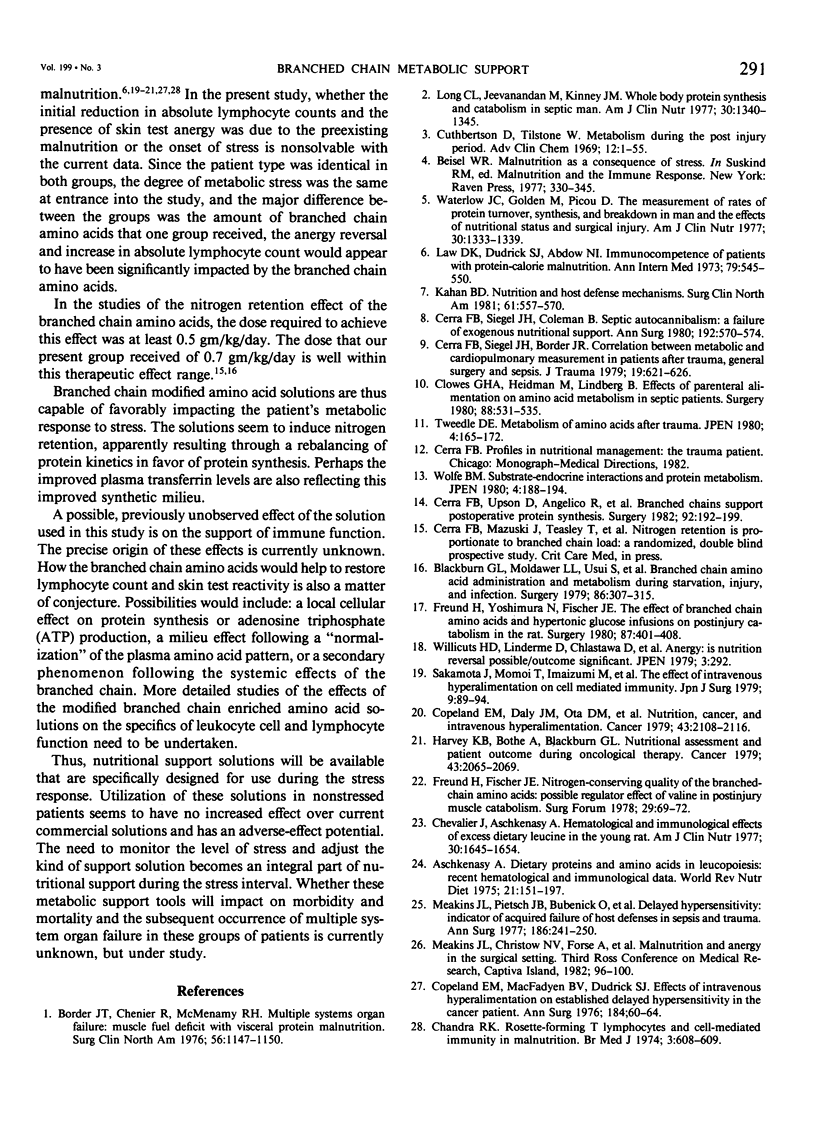
Selected References
These references are in PubMed. This may not be the complete list of references from this article.
- Aschkenasy A. Dietary proteins and amino acids in leucopoiesis: recent hematological and immunological data. World Rev Nutr Diet. 1975;21:151–197. doi: 10.1159/000397968. [DOI] [PubMed] [Google Scholar]
- Blackburn G. L., Moldawer L. L., Usui S., Bothe A., Jr, O'Keefe S. J., Bistrian B. R. Branched chain amino acid administration and metabolism during starvation, injury, and infection. Surgery. 1979 Aug;86(2):307–315. [PubMed] [Google Scholar]
- Border J. R., Chenier R., McManamy R. H., La Duca J., Seibel R., Birkhahn R., Yu L. Multiple systems organ failure: muscle fuel deficit with visceral protein malnutrition. Surg Clin North Am. 1976 Oct;56(5):1147–1167. doi: 10.1016/s0039-6109(16)41035-2. [DOI] [PubMed] [Google Scholar]
- Cerra F. B., Siegel J. H., Border J. R., Peters D. M., McMenamy R. R. Correlations between metabolic and cardiopulmonary measurements in patients after trauma, general surgery, and sepsis. J Trauma. 1979 Aug;19(8):621–629. doi: 10.1097/00005373-197908000-00010. [DOI] [PubMed] [Google Scholar]
- Cerra F. B., Siegel J. H., Coleman B., Border J. R., McMenamy R. R. Septic autocannibalism. A failure of exogenous nutritional support. Ann Surg. 1980;192(4):570–580. doi: 10.1097/00000658-198010000-00015. [DOI] [PMC free article] [PubMed] [Google Scholar]
- Cerra F. B., Upson D., Angelico R., Wiles C., 3rd, Lyons J., Faulkenbach L., Paysinger J. Branched chains support postoperative protein synthesis. Surgery. 1982 Aug;92(2):192–199. [PubMed] [Google Scholar]
- Chandra R. K. Rosette-forming T lymphocytes and cell-mediated immunity in malnutrition. Br Med J. 1974 Sep 7;3(5931):608–609. doi: 10.1136/bmj.3.5931.608. [DOI] [PMC free article] [PubMed] [Google Scholar]
- Chevalier P., Aschkenasy A. Hematological and immunological effects of excess dietary leucine in the young rat. Am J Clin Nutr. 1977 Oct;30(10):1645–1654. doi: 10.1093/ajcn/30.10.1645. [DOI] [PubMed] [Google Scholar]
- Clowes G. H., Jr, Heideman M., Lindberg B., Randall H. T., Hirsch E. F., Cha C. J., Martin H. Effects of parenteral alimentation on amino acid metabolism in septic patients. Surgery. 1980 Oct;88(4):531–543. [PubMed] [Google Scholar]
- Copeland E. M., 3rd, Daly J. M., Ota D. M., Dudrick S. J. Nutrition, cancer, and intravenous hyperalimentation. Cancer. 1979 May;43(5 Suppl):2108–2116. doi: 10.1002/1097-0142(197905)43:5+<2108::aid-cncr2820430720>3.0.co;2-6. [DOI] [PubMed] [Google Scholar]
- Copeland E. M., Fadyen B. V., Jr, Dudrick S. J. Effect of intravenous hyperalimentation on established delayed hypersensitivity in the cancer patient. Ann Surg. 1976 Jul;184(1):60–64. doi: 10.1097/00000658-197607000-00010. [DOI] [PMC free article] [PubMed] [Google Scholar]
- Cuthbertson D., Tilstone W. J. Metabolism during the postinjury period. Adv Clin Chem. 1969;12:1–55. doi: 10.1016/s0065-2423(08)60257-7. [DOI] [PubMed] [Google Scholar]
- Freund H., Fischer J. E. Nitrogen-conserving quality of the branched-chain amino acids: possible regulator effect of valine in postinjury muscle catabolism. Surg Forum. 1978;29:69–71. [PubMed] [Google Scholar]
- Freund H., Yoshimura N., Fischer J. E. The effect of branched chain amino acids and hypertonic glucose infusions on postinjury catabolism in the rat. Surgery. 1980 Apr;87(4):401–408. [PubMed] [Google Scholar]
- Harvey K. B., Bothe A., Jr, Blackburn G. L. Nutritional assessment and patient outcome during oncological therapy. Cancer. 1979 May;43(5 Suppl):2065–2069. doi: 10.1002/1097-0142(197905)43:5+<2065::aid-cncr2820430714>3.0.co;2-1. [DOI] [PubMed] [Google Scholar]
- Kahan B. D. Nutrition and host defense mechanisms. Surg Clin North Am. 1981 Jun;61(3):557–570. doi: 10.1016/s0039-6109(16)42437-0. [DOI] [PubMed] [Google Scholar]
- Law D. K., Dudrick S. J., Abdou N. I. Immunocompetence of patients with protein-calorie malnutrition. The effects of nutritional repletion. Ann Intern Med. 1973 Oct;79(4):545–550. doi: 10.7326/0003-4819-79-4-545. [DOI] [PubMed] [Google Scholar]
- Long C. L., Jeevanandam M., Kim B. M., Kinney J. M. Whole body protein synthesis and catabolism in septic man. Am J Clin Nutr. 1977 Aug;30(8):1340–1344. doi: 10.1093/ajcn/30.8.1340. [DOI] [PubMed] [Google Scholar]
- Meakins J. L., Pietsch J. B., Bubenick O., Kelly R., Rode H., Gordon J., MacLean L. D. Delayed hypersensitivity: indicator of acquired failure of host defenses in sepsis and trauma. Ann Surg. 1977 Sep;186(3):241–250. doi: 10.1097/00000658-197709000-00002. [DOI] [PMC free article] [PubMed] [Google Scholar]
- Sakamoto J., Momoi T., Imaizumi M., Ichihashi H., Kamei H., Kondo T. The effect of intravenous hyperalimentation on cell mediated immunity. Jpn J Surg. 1979 Jun;9(2):89–94. doi: 10.1007/BF02468842. [DOI] [PubMed] [Google Scholar]
- Tweedle D. E. Metbolism of amino acids after trauma. JPEN J Parenter Enteral Nutr. 1980 Mar-Apr;4(2):165–172. doi: 10.1177/014860718000400219. [DOI] [PubMed] [Google Scholar]
- Waterlow J. C., Golden J., Picou D. The measurements of rates of protein turnover, synthesis, and breakdown in man and the effects of nutritional status and surgical injury. Am J Clin Nutr. 1977 Aug;30(8):1333–1339. doi: 10.1093/ajcn/30.8.1333. [DOI] [PubMed] [Google Scholar]
- Wolfe B. M. Substrate-endocrine interactions and protein metabolism. JPEN J Parenter Enteral Nutr. 1980 Mar-Apr;4(2):188–194. doi: 10.1177/014860718000400224. [DOI] [PubMed] [Google Scholar]


